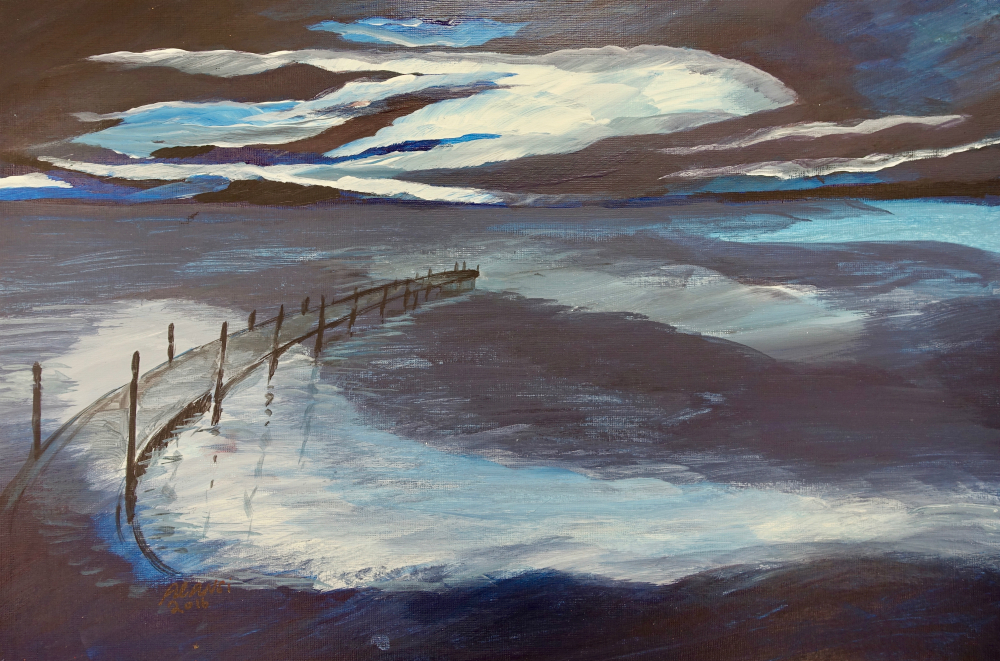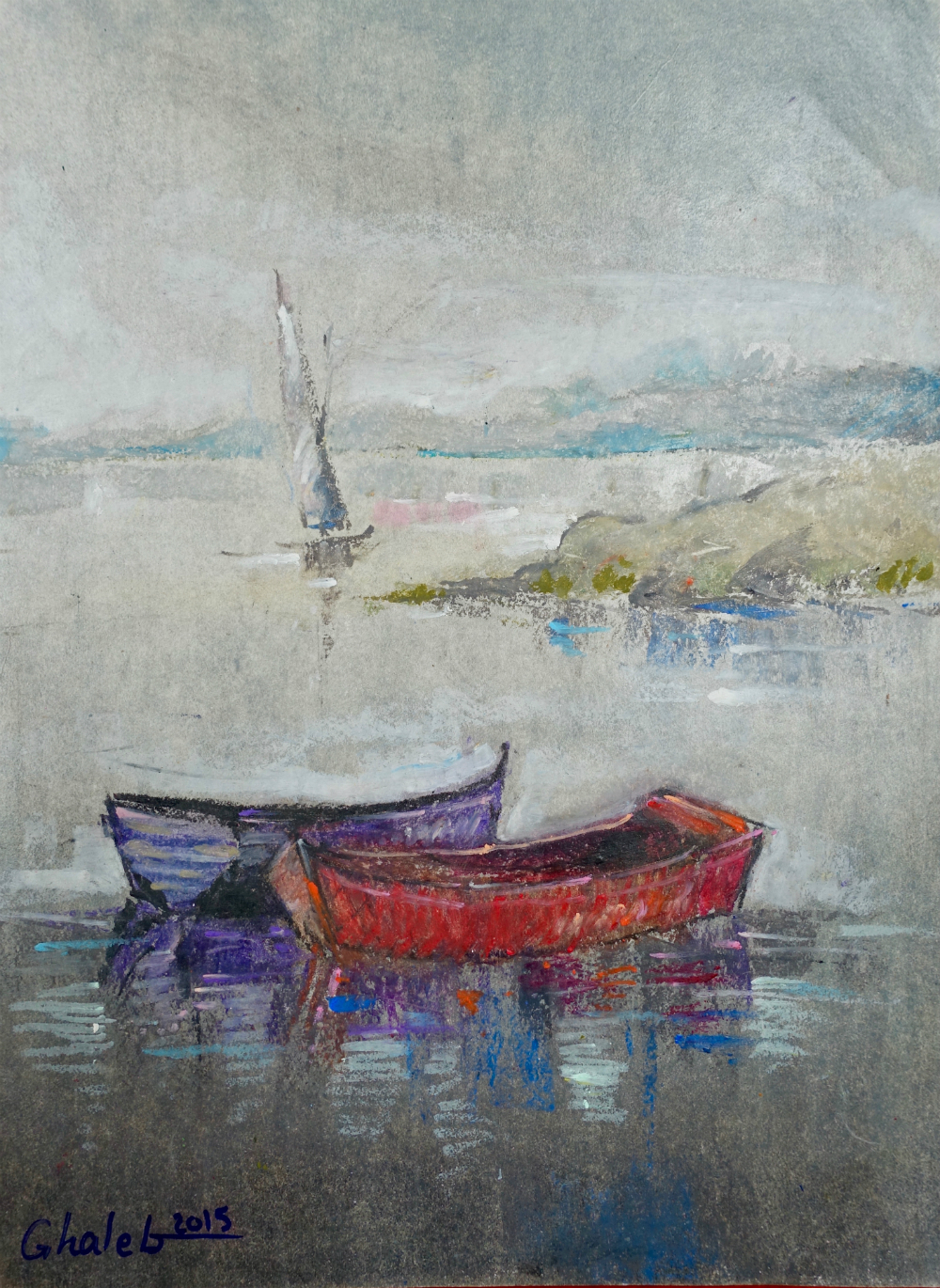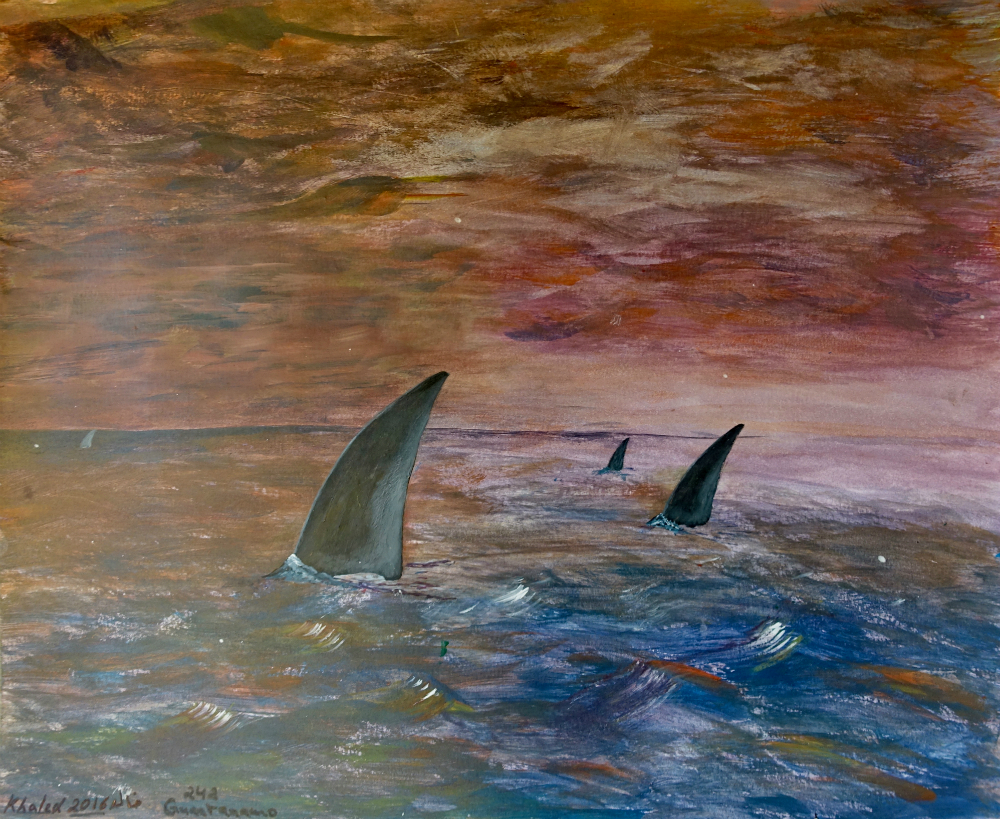EDITOR’S NOTE: This article originally appeared at TomDispatch.com. To stay on top of important articles like these, sign up to receive the latest updates from TomDispatch.com.
We spent the day at a beach in Brooklyn. Skyscrapers floated in the distance and my toddler kept handing me cigarette filters she had dug out of the sand. When we got home, I checked my e-mail. I had been sent a picture of a very different beach: deserted, framed by distant headlands with unsullied sands and clear waters. As it happened, I was looking not at a photograph but at a painting by a man imprisoned at the Guantánamo Bay detention camp.
Of the roughly 780 people once imprisoned there, he is one of 41 prisoners who remain, living yards away from the Caribbean Sea. Captives from the Bush administration’s Global War on Terror began to arrive at that offshore prison in January 2002. Since Guantánamo is located on a military base in Cuba and the detainees were labeled “alien enemy combatants,” they were conveniently to be without rights under either United States or international law and so open to years of whatever their jailers wanted to do to them (including torture). President Barack Obama released 197 of them in his years in office, but was unable to fulfill the promise he made on his first day: to close Guantánamo.
The man whose painting I saw has been held for nearly 15 years without trial, without even having charges filed against him. The e-mail came from his lawyer who had volunteered to defend a number of Guantánamo detainees. Some had been released after she helped them convince a military tribunal that they were no longer “threats” to the United States. The others remain in indefinite detention. Many of her clients pass their time by making art and, of all the unexpected things to come into my life, she was now looking for a curator who wanted to exhibit some of their paintings.
Collecting the Art of Guantánamo
I’m a professor at John Jay College in New York City. It has a small art gallery, and so one day in August 2016 I found myself in that lawyer’s midtown Manhattan office preparing, however dubiously, to view the art of her clients. She was pushing aside speakerphones and notepads and laying out the artwork on a long table in a conference room whose windows overlooked the picturesque East River. As I waited, I watched from high up as the water cut a swath of silence through the city. When I finally turned my attention to the art, I was startled to see some eerily similar views. Painting after painting of water. Water trickling through the reeds at the edge of a pond. Water churning into foam as it ran over rocks in rivers. Calmly flowing water that reflected the buildings along a canal.
Popular
"swipe left below to view more authors"Swipe →But above all, there was the sea. Everywhere, the sea. In those paintings in that conference room and in other work sent to me as word spread among detainees and their lawyers that I was willing to plan an exhibit, I found hundreds of depictions of the sea in all its moods. In some paintings, storms thrashed apart the last planks of sinking ships. In others, boats were moored safely at docks or scudded across vast expanses of water without a hint of shore in sight. Clouds bunched in blue midday skies or burned orange in mid-ocean sunsets. One detainee had even made elaborate models of sailing ships out of cardboard, old T-shirts, bottle caps, and other scraps of trash.
Puzzled, I asked the lawyer, “Why all the water?” She shrugged. Maybe the art instructor at the prison, she suggested, was giving the detainees lots of pictures of the sea. The detainees, it turned out, could actually take art classes as long as they remained “compliant.” But when there was a crackdown, as there had, for instance, been during a mass hunger strike in 2013, the guards promptly confiscated their art—and that was the reason the lawyer’s clients had asked her to take it. They wanted to keep their work (and whatever it meant to them) safe from the guards.
As it turned out, the art doesn’t leave Guantánamo that much more easily than the prisoners themselves. Military authorities scrutinized every piece for hidden messages and then stamped the back of each work, “Approved by US Forces.” Those stamps generally bled through, floating up into the surface of the image on the other side. The lawyer had even nicknamed one of the model ships the USS Approved because the censors had stamped those words across its sails.
So I found myself beginning to plan an exhibition of a sort I had never in my wildest dreams imagined I would curate. And I began to worry. A curator makes so many choices, judgments, interpretations of art. But how could I make them with any kind of accuracy when I was a woman, a non-Muslim, and a citizen of the very nation that had detained these men for so many years without charges or trial? Wasn’t I, in other words, the ultimate Other?
Greek to Me
By training, I’m a classical art historian. I expand fragments. If I show my students a broken ancient Greek vase, I use my words to mend it. I pour in more words to fill it with the memory of the wine it once carried, yet more to conjure up the men who once drank from it, and still more to offer my students our best guesses at what they might have been talking about as they drank.
This mode of dealing with art was known to the ancient Greeks. They called it ekphrasis: the rhetorical exercise of describing a work of art in great detail. For them, ekphrasis was a creative act. The speaker often explained things not shown by the artist, such as what happened just before or just after the illustrated moment. The maiden in this painting is smiling because she has just received a declaration of love, they would say.
But faced with this art from Guantánamo, ekphrasis seemed somehow inappropriate. These artists are still alive, even if entombed. Their artworks are as they intended them, not the fragmentary remains of some past world that needs a framework of interpretation. And whatever interpretation these might need, how in the world was I to provide it? Who was I to pour my words over them?
And yet I knew that they needed help or why would that lawyer have come to me? The detainees certainly couldn’t curate their own exhibit in New York because they would be barred from entering the United States even after being released from Guantánamo. So I told myself that I would have to help them realize their desire for an exhibit without inserting my own judgments. I told myself that I would instead be their amanuensis.
From the Latin: a manu, servant of the hand, the term once referring to someone who aided in an artistic project by taking dictation. Consider, for instance, John Milton’s daughters, Mary and Deborah, who took down his 17th-century epic poem Paradise Lost after he had gone blind. They were his amanuenses. He composed the verses in his head at night. Then, in the morning, as a contemporary of his wrote, he “sat leaning backward obliquely in an easy chair, with his leg flung over the elbow of it” while they wrote down what he recited. If they dawdled coming to him, he would complain that he needed to be milked.
I would similarly let the artists speak for themselves through me, or so I thought. I wrote out a list of questions for their lawyers to ask them, including “What do you like about making art?” and “What would you like people to think about when they are looking at your art?” Then I waited for those lawyers to pose them during their Guantánamo visits in the midst of conferences about legal matters.
The answers were strikingly uniform and seemingly unrevealing. They wanted people to see their art, they said, and through it know that they are actual human beings. Really? I didn’t get it. Of course, they’re human beings. What else could they be?
At first, I wasn’t too concerned that their answers didn’t really make much sense to me. That’s part of the role of an amanuensis. Milton’s daughters were ten and six when he began Paradise Lost. It would take them all nearly a decade to finish it. In those years, their father also taught them to read books aloud to him in Greek, Latin, and Hebrew, of which they couldn’t understand a word.
I was used to being an amanuensis myself. When I was a year and a half old and my mother was still pregnant with my sister, my father had an accident and broke his neck. The fractured edge of a vertebra sliced into his spinal cord, leaving his arms and legs paralyzed. As soon as we were old enough—and I can’t remember a time when we weren’t considered old enough—my sister and I would spend hours a day being his “hands.” We opened mail, paid bills, slid computer disks in and out of the desktop that he operated by stabbing at the keys with a long pointer held in his mouth. Through us, two daydreamy little girls, he did all the work of a stereotypical man of the house—fixing broken appliances, hanging Christmas lights, grilling steak.
To be an amanuensis is, by the way, anything but a passive act. After all, there wouldn’t be enough time in the world if you had to tell your own hands what to do in every situation: reach for the coffee cup, close that finger around its handle, bring it to your mouth. In the same way, an amanuensis must anticipate needs, prepare tools, and know when something’s missing.
And this sense that something was missing—honed from my years with my father—was growing in me as I looked at the artwork and thought about those responses. It was the midsummer of 2017 and the exhibit was set to open in the fall. The file cabinets in my office were filled with paintings, overflowing into piles on the floor that came up to my shins. After the struggle to pry those artworks out of Guantánamo, I didn’t know how to say that one piece should be seen by the world and another should stay a prisoner in some dark drawer.
Freedom of the Seas
So I asked again—this time by e-mailing Mansoor Adayfi, a former detainee working on a memoir about his time at Guantánamo. He explained that the cells of detainees were right by the sea. They could smell and hear the surf, but because tarps blocked their view, they could never see it. Only once, when a hurricane was coming, had the guards removed those tarps from the fences that separated them from the water. A few days later, when they went back up, the artist-inmates began to draw pictures of the sea as a substitute for what they had glimpsed during that brief moment of visual freedom.
Suddenly, those endless visions of water—that is, of freedom—made sense to me. And I understood something else as well. Guantánamo is a system designed to paint the men it holds as monsters, animals, sub-humans who don’t deserve basic rights like fair trials. That was the reason those prisoners were speaking, but not speaking, in their art. Why would they say anything that risked a further fall from whatever precarious hold on humanity they still had?
They hoped someday to be released, which was unlikely to happen if the authorities became convinced that they bore any anger towards the United States. And even release would not mean freedom of speech, since they would be sent to countries that had agreed to host them. Dependent on the good graces of these governments, they would continue to live constrained lives in constrained circumstances, needing never to offend these new sets of authorities either.
I was indeed the Other. I might misinterpret and misrepresent, but so undoubtedly would anyone else in our world speaking for those artists. And they were incapable of speaking for themselves.
So I added an essay of my own to the catalog, becoming ekphrastic. I pointed out what was movingly missing in their artwork. It wasn’t that there weren’t people in their paintings. It was that those works had invisible holes where the people should have been. All those unmanned boats, sailing across those open waters, were carrying invisible self-portraits of the artists as they hardly dared to imagine themselves: free. Even when there were no boats, the famously mutable sea served as the perfect disguise. Its winds and waves and rocks represented the all-too-human emotions of the artists without ever making them visible to the censors.
It was, of course, so much less dangerous for me to interpret what they were saying than for them to say it directly. I had held many doors open for my father when I was his amanuensis, running ahead to make sure the path was clear and that there were no surprising flights of stairs. If there were, it was up to me to find a new way.
This is what I wanted to do for the artists. Open doors, scout out paths—but their choice of doors, their choice of paths, not mine. They had told me they wanted people to see them as human beings and that was the case I tried to make for them.
As it turned out, I evidently succeeded a little too well. After the exhibit opened and received a surprising amount of media attention, the artists’ lawyers noticed that the authorities were taking longer and longer to clear artworks to leave Guantánamo. Then, three weeks ago, the Department of Defense declared that all art made at Guantánamo is government property. Detainees reported that their guards then told them any art left behind if they were ever released would be burned and works in their cells deemed “excess” would simply be discarded.
As with so many policy decisions about Guantánamo, the true rationale for this one remains hidden. My guess: the US authorities there were surprised that the artwork they had been scrutinizing so carefully for hidden messages had a unifying one they had missed: that its makers were human beings. Which is precisely the realization the authorities need to stop the rest of us from having if Guantánamo is to remain open.
Note: The exhibit “Ode to the Sea: Art from Guantánamo” is on display in New York City at the President’s Gallery of John Jay College, 899 10th Avenue (6th Floor) until January 28, 2018.





